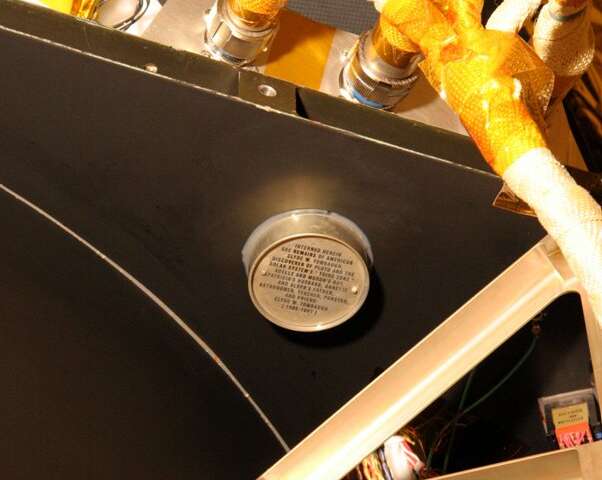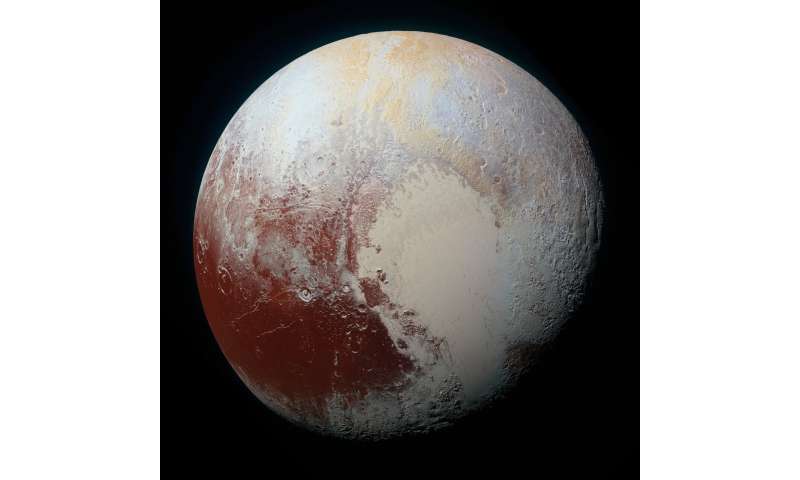by New Horizons FEBRUARY 19, 2020

The New Horizons spacecraft carries a small container of Clyde Tombaugh's ashes on its inside upper deck. An inscription on it, written by mission Principal Investigator Alan Stern, reads: "Interred herein are remains of American Clyde W. Tombaugh, discoverer of Pluto and the solar system's "Third Zone," Adelle and Muron's boy, Patricia's husband, Annette and Alden's father, astronomer, teacher, punster, and friend: Clyde W. Tombaugh (1906-1997)." Credit: NASA/Johns Hopkins University Applied Physics Laboratory/Southwest Research Institute
Ninety years ago today, Clyde Tombaugh, a young astronomer working at Lowell Observatory in Flagstaff, Arizona, discovered Pluto. In doing so he unknowingly opened the door to the vast "third zone" of the solar system we now know as the Kuiper Belt, containing countless planetesimals and dwarf planets—the third class of planets in our solar system.
Lowell Observatory's namesake, Percival Lowell, first proposed the existence of a "Planet X" somewhere beyond the orbit of Neptune. Unable to find it before his death in 1916, the search for Planet X stalled for nearly a decade until renewed when Tombaugh was hired in 1929. Tombaugh found the object on February 18, 1930, at the age of 24, using a Zeiss blink comparator, a device that allowed him to spot moving objects against the background star fields he had photographed.
"What Tombaugh didn't know then was that Planet X would launch the era of exploration in the third zone of the solar system," said Thomas Zurbuchen, associate administrator for NASA's Science Mission Directorate. "Science builds on science, and this discovery helped pave the way for New Horizons' exploration of this uncharted region."
Although he died in 1997, Tombaugh's ashes were aboard NASA's New Horizons spacecraft when it launched from Cape Canaveral Air Force Station, Florida, in January 2006. Those ashes, carried in a small canister on the spacecraft, traveled with New Horizons on a nine-year, three-billion-mile journey to Pluto to make the first exploration of Tombaugh's planet.
 NASA's New Horizons spacecraft captured this high-resolution enhanced color view of Pluto on July 14, 2015. The image combines blue, red and infrared images taken by the Ralph/Multispectral Visual Imaging Camera (MVIC). Pluto's surface sports a remarkable range of subtle colors, enhanced in this view to a rainbow of pale blues, yellows, oranges, and deep reds. Many landforms have their own distinct colors, telling a complex geological and climatological story that scientists have only just begun to decode. The image resolves details and colors on scales as small as 0.8 miles (1.3 kilometers). Credit: NASA/Johns Hopkins University Applied Physics Laboratory/Southwest Research Institute
NASA's New Horizons spacecraft captured this high-resolution enhanced color view of Pluto on July 14, 2015. The image combines blue, red and infrared images taken by the Ralph/Multispectral Visual Imaging Camera (MVIC). Pluto's surface sports a remarkable range of subtle colors, enhanced in this view to a rainbow of pale blues, yellows, oranges, and deep reds. Many landforms have their own distinct colors, telling a complex geological and climatological story that scientists have only just begun to decode. The image resolves details and colors on scales as small as 0.8 miles (1.3 kilometers). Credit: NASA/Johns Hopkins University Applied Physics Laboratory/Southwest Research Institute
The spacecraft flew past Pluto and its five moons on July 14, 2015, coming to within 7,800 miles (12,500 kilometers) of the surface and delivering the now iconic images of Pluto and its heart, as well as all five of its moons: Charon, Nix, Hydra, Styx and Kerberos. The flyby revolutionized humankind's understanding of the Pluto system and dwarf planets. From the variety in its geological landforms, to its complex atmosphere, to its intriguing moons, Pluto showed a level of physical diversity and complexity that few expected to find.
Once thought by some to be only an icy rock, New Horizons discovered that Pluto is actually geologically active. From strange, bladed methane mountains to nitrogen glaciers, to ice volcanoes and the now suspected presence of a liquid water ocean inside the planet, Pluto has literally caused planetary scientists to rethink how complex and active small planets can be. Pluto also has a brilliant blue nitrogen atmosphere, replete with hazes stretching half a million meters into its sky and possible ground fogs and clouds.
Following the success of the Pluto flyby, NASA extended the New Horizons mission to fly past a small Kuiper Belt object a billion miles beyond Pluto. On Jan. 1, 2019, New Horizons brought that ancient body, Arrokoth, into focus and, in doing so, revealed how planetesimals—the building blocks of planets like Pluto—were formed.
"Looking back, Tombaugh's discovery was so much more than just the discovery of the ninth planet," said New Horizons Principal Investigator Alan Stern, of the Southwest Research Institute. "It was the harbinger of a whole new region of the solar system and two different and completely new types of bodies—dwarf planets and Kuiper Belt objects. I only wish that Clyde had lived to see all that New Horizons discovered and how stunningly beautiful Pluto is."
Explore further SwRI to plan Pluto orbiter mission
Provided by New Horizons
Ninety years ago today, Clyde Tombaugh, a young astronomer working at Lowell Observatory in Flagstaff, Arizona, discovered Pluto. In doing so he unknowingly opened the door to the vast "third zone" of the solar system we now know as the Kuiper Belt, containing countless planetesimals and dwarf planets—the third class of planets in our solar system.
Lowell Observatory's namesake, Percival Lowell, first proposed the existence of a "Planet X" somewhere beyond the orbit of Neptune. Unable to find it before his death in 1916, the search for Planet X stalled for nearly a decade until renewed when Tombaugh was hired in 1929. Tombaugh found the object on February 18, 1930, at the age of 24, using a Zeiss blink comparator, a device that allowed him to spot moving objects against the background star fields he had photographed.
"What Tombaugh didn't know then was that Planet X would launch the era of exploration in the third zone of the solar system," said Thomas Zurbuchen, associate administrator for NASA's Science Mission Directorate. "Science builds on science, and this discovery helped pave the way for New Horizons' exploration of this uncharted region."
Although he died in 1997, Tombaugh's ashes were aboard NASA's New Horizons spacecraft when it launched from Cape Canaveral Air Force Station, Florida, in January 2006. Those ashes, carried in a small canister on the spacecraft, traveled with New Horizons on a nine-year, three-billion-mile journey to Pluto to make the first exploration of Tombaugh's planet.
 NASA's New Horizons spacecraft captured this high-resolution enhanced color view of Pluto on July 14, 2015. The image combines blue, red and infrared images taken by the Ralph/Multispectral Visual Imaging Camera (MVIC). Pluto's surface sports a remarkable range of subtle colors, enhanced in this view to a rainbow of pale blues, yellows, oranges, and deep reds. Many landforms have their own distinct colors, telling a complex geological and climatological story that scientists have only just begun to decode. The image resolves details and colors on scales as small as 0.8 miles (1.3 kilometers). Credit: NASA/Johns Hopkins University Applied Physics Laboratory/Southwest Research Institute
NASA's New Horizons spacecraft captured this high-resolution enhanced color view of Pluto on July 14, 2015. The image combines blue, red and infrared images taken by the Ralph/Multispectral Visual Imaging Camera (MVIC). Pluto's surface sports a remarkable range of subtle colors, enhanced in this view to a rainbow of pale blues, yellows, oranges, and deep reds. Many landforms have their own distinct colors, telling a complex geological and climatological story that scientists have only just begun to decode. The image resolves details and colors on scales as small as 0.8 miles (1.3 kilometers). Credit: NASA/Johns Hopkins University Applied Physics Laboratory/Southwest Research InstituteThe spacecraft flew past Pluto and its five moons on July 14, 2015, coming to within 7,800 miles (12,500 kilometers) of the surface and delivering the now iconic images of Pluto and its heart, as well as all five of its moons: Charon, Nix, Hydra, Styx and Kerberos. The flyby revolutionized humankind's understanding of the Pluto system and dwarf planets. From the variety in its geological landforms, to its complex atmosphere, to its intriguing moons, Pluto showed a level of physical diversity and complexity that few expected to find.
Once thought by some to be only an icy rock, New Horizons discovered that Pluto is actually geologically active. From strange, bladed methane mountains to nitrogen glaciers, to ice volcanoes and the now suspected presence of a liquid water ocean inside the planet, Pluto has literally caused planetary scientists to rethink how complex and active small planets can be. Pluto also has a brilliant blue nitrogen atmosphere, replete with hazes stretching half a million meters into its sky and possible ground fogs and clouds.
Following the success of the Pluto flyby, NASA extended the New Horizons mission to fly past a small Kuiper Belt object a billion miles beyond Pluto. On Jan. 1, 2019, New Horizons brought that ancient body, Arrokoth, into focus and, in doing so, revealed how planetesimals—the building blocks of planets like Pluto—were formed.
"Looking back, Tombaugh's discovery was so much more than just the discovery of the ninth planet," said New Horizons Principal Investigator Alan Stern, of the Southwest Research Institute. "It was the harbinger of a whole new region of the solar system and two different and completely new types of bodies—dwarf planets and Kuiper Belt objects. I only wish that Clyde had lived to see all that New Horizons discovered and how stunningly beautiful Pluto is."
Explore further SwRI to plan Pluto orbiter mission
Provided by New Horizons
No comments:
Post a Comment